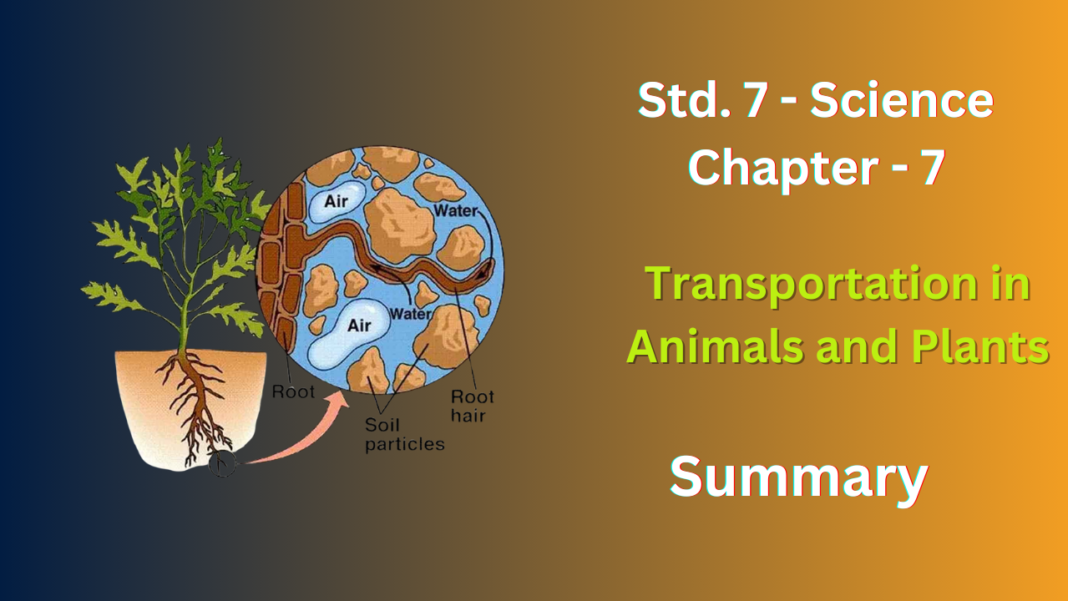NCERT Solutions for Class 7 Science Chapter 7
The Transportation in Animals and Plants chapter explores how essential substances move throughout living organisms:
The Need for Transport:
- All living things need a way to transport materials like nutrients, oxygen, waste products, and water throughout their bodies.
- Without this transport system, cells wouldn’t receive the materials they need to function and grow, and waste products wouldn’t be removed, leading to problems.
Transportation Systems:
- Animals:
- Depend on a complex circulatory system for transport.
- The circulatory system involves a network of blood vessels and a pumping heart.
- Blood carries oxygen, nutrients, and waste products throughout the body.
- Plants:
- Have a simpler transport system using specialized tissues.
- Xylem: Carries water and dissolved minerals upwards from the roots to the leaves.
- Phloem: Transports dissolved food (sugars) made in the leaves to other parts of the plant.
Key Points:
- Animals have a closed circulatory system where blood stays within vessels.
- Plants have an open circulatory system where transport happens through tissues, not enclosed vessels.
- Efficient transport is crucial for maintaining healthy growth and function in both animals and plants.
Additional Details You Might Encounter:
- In some animals (insects), transport happens through a network of tubes called tracheae.
- Plants also use the process of diffusion for short-distance movement of gases.
Learning about Transport Helps Us Understand:
- How nutrients reach all parts of an organism.
- How oxygen gets delivered to cells for respiration.
- How waste products get removed from cells.
NCERT Solutions for Class 7 Science Chapter 7
Exercises
1.Match structures given in Column I with functions given in Column II.
| Column I | Column II |
| Stomata | Absorption of Water |
| Xylem | Transpiration |
| Root hairs | Transport of food |
| Phloem | Transport of water |
| Synthesis of carbohydrates |
Ans :
| Column I | Column II |
| Stomata | Transpiration |
| Xylem | Transport of water |
| Root hairs | Absorption of Water |
| Phloem | Transport of food |
2.-Fill in the blanks :
(i) The blood from the heart is transported to all parts of the body by the _____________
(ii) Haemoglobin is present in ___________ cells.
(iii) Arteries and veins are joined by a network of ___________ .
(iv) The rhythmic expansion and contraction of the heart is called ___________
(v) The main excretory product in human beings is ___________
(vi) Sweat contains water and .
(vii) Kidneys eliminate the waste materials in the liquid form called .
(viii) Water reaches great heights in the trees because of suction pull caused by .
Ans :
(i) arteries
(ii) red blood cells
(in) capillaries
(iv) heartbeat
(v) urea
(vi) salts
(vii) urine
(viii) transpiration.
3.Choose the correct options:
(a) In plants, water is transported through
(i) Xylem (ii) Phloem (iii) Stomata (iv) Root hair
(b) Water absorption through roots can be increased by keeping the plants
(i) In the shade (ii) in dim light (iii) under the fan (iv) covered with a polythene bag
Ans :
(a) (i) Xylem
(b) (iii) under the fan
4.Why is transport of materials necessary in a plant or an animal? Explain.
Ans : Plants and animals need transport systems to:
- Deliver food and oxygen: Like a delivery truck, transport brings supplies to all parts.
- Remove waste: It takes away trash (waste products) cells create.
- Keep things balanced: It helps maintain a stable internal environment, like a well-functioning room.
Without transport, organisms would be like a messy house with no deliveries or garbage removal!
5.What will happen if there are no platelets in the blood?
Ans : If there are no platelets in the blood, a serious condition called thrombocytopenia occurs. This lack of platelets has a significant impact on blood clotting, leading to the following consequences:
- Uncontrolled Bleeding: Platelets are essential for forming blood clots, which seal wounds and prevent excessive blood loss. Without platelets, even minor injuries can bleed excessively and may be difficult to stop.
- Internal Bleeding: The risk of internal bleeding also increases. This can happen in various organs and cause significant health problems.
- Complications: Excessive blood loss can lead to dizziness, weakness, and even shock. In severe cases, it can be life-threatening.
6.What are stomata? Give two junctions of stomata.
Ans : Stomata are microscopic openings found mainly on the underside of leaves. They act like little valves that control the exchange of gases between the plant and the environment.
Two Crucial Functions of Stomata:
- Taking in Carbon Dioxide (CO2): CO2 is essential for photosynthesis, the process by which plants make their food. Stomata open to allow CO2 from the air to enter the leaves.
- Releasing Water Vapor (H2O): Plants lose water vapor through transpiration, a process that helps regulate temperature and draw water up from the roots. Stomata open and close to control the rate of transpiration.
7.Does transpiration serve any useful function in plants? Explain.
Ans : Absolutely, transpiration, the process by which plants release water vapor through stomata, serves several important functions in plants:
- Upward Movement of Water: Transpiration creates a suction pull within the plant. This pull, similar to how a straw works, helps draw water and dissolved minerals from the roots up the xylem (vascular tissue) to the leaves.
- Temperature Regulation: Plants don’t sweat like humans, but transpiration serves a similar purpose. As water evaporates from the leaves, it absorbs heat, helping to cool the plant down, especially on hot days.
- Gas Exchange: Stomata opening and closing also regulate the intake of carbon dioxide (needed for photosynthesis) and the release of oxygen. Transpiration helps facilitate this vital gas exchange.
- Structural Support: The constant flow of water through the xylem helps to keep plant structures rigid and upright.
8.What are the components of blood?
Ans :
- Plasma: The liquid carrying stuff like nutrients and waste. (Imagine the truck bed)
- Red Blood Cells: Carry oxygen throughout the body. (Think of oxygen tanks)
- White Blood Cells: Fight infection, like bodyguards.
- Platelets: Help clot blood to stop bleeding, like repair crew patching leaks.
9.Why is blood needed by all the parts of a body?
Ans : Blood is like a super delivery truck for your body! Here’s why all parts need it:
- Delivers goodies: Oxygen, nutrients, and water to keep cells happy.
- Takes out trash: Carries away waste products like carbon dioxide.
- Keeps things balanced: Helps maintain body temperature and delivers hormones.
10.What makes the blood look red?
Ans : The red color of blood comes from a protein called hemoglobin present inside red blood cells (RBCs).
11.Describe the function of the heart.
Ans : The heart acts as the pump of the circulatory system, constantly moving blood throughout your body.
- Continuous Pumping: The heart rhythmically contracts and relaxes to push blood through a network of vessels (arteries and veins).
- Two Loops: It works in a double loop system:
- Oxygenated Blood: The right side of the heart receives oxygen-rich blood from the lungs and pumps it to the body (through arteries).
- Deoxygenated Blood: The left side of the heart receives oxygen-depleted blood from the body (through veins) and pumps it back to the lungs for oxygenation.
- Maintaining Pressure: The heart maintains sufficient blood pressure to ensure proper circulation throughout the body.
12.Why is it necessary to excrete waste products?
Ans : Our bodies create waste products like a factory creates smoke. We need to get rid of this waste (excrete it) because:
- It’s Toxic Trash: Waste buildup is like trash piling up – it can damage the body.
- Keeps Things Clean: Excretion removes this trash, keeping our internal environment healthy.
13.Draw a diagram of the human excretory system and label the various parts.
Ans :

NCERT Solutions for Class 7 Science Chapter 7
FAQ’s
How can NCERT Solutions for Class 7 Science Chapter 7 help me understand the concept of transportation in animals and plants?
NCERT Solutions provide detailed explanations and answers to questions related to the transport of essential substances in organisms. By studying these solutions, you can gain a deeper understanding of how animals and plants transport nutrients, water, and other substances vital for their survival.
Are the NCERT Solutions for Chapter 7 accessible for free on Education85?
Yes, all NCERT Solutions for Class 7 Science Chapter 7 on Transportation in Animals and Plants are available for free on Education85. Simply navigate to the relevant section to access these resources.
Can I use NCERT Solutions for Class 7 Science Chapter 7 as a primary study resource for my science exams?
Absolutely! NCERT Solutions provide comprehensive explanations and answers to questions that are crucial for understanding the concepts covered in Chapter 7. They serve as an excellent primary study resource for your science exams.
Are there any practice questions or exercises included in the NCERT Solutions for Class 7 Science Chapter 7?
Yes, along with detailed explanations, the NCERT Solutions for Chapter 7 include practice questions and exercises to help reinforce your understanding of the concept of transportation in animals and plants.
How can I access NCERT Solutions for Class 7 Science Chapter 7 on Education85?
You can easily access NCERT Solutions for Chapter 7 by visiting the Class 7 Science section on Education85 and selecting Chapter 7: Transportation in Animals and Plants. From there, you can view, download, or print the solutions as needed.









